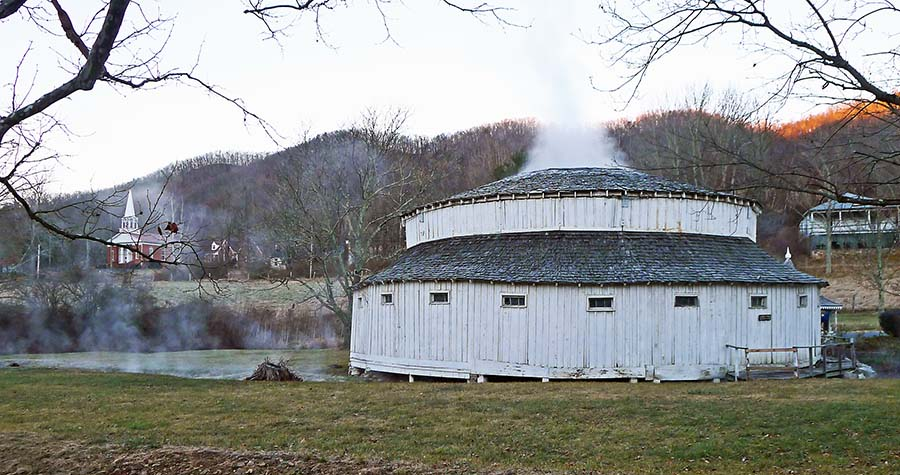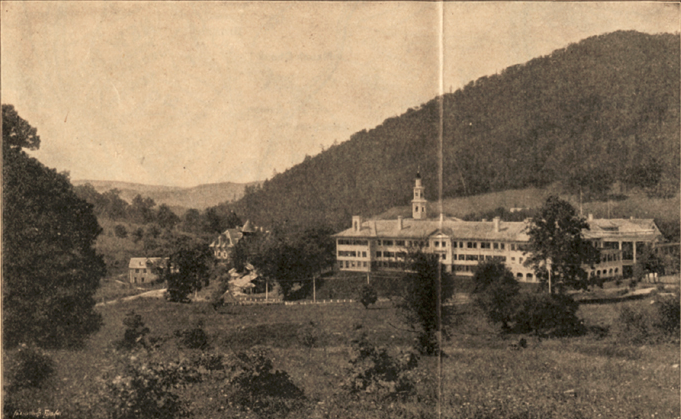
in the 1800's, wealthy tourists in Virginia would visit the Jefferson Pools at the resort in Warm Springs
Source: Virginia Department of Mines, Minerals and Energy, Geothermal Energy

in the 1800's, wealthy tourists in Virginia would visit the Jefferson Pools at the resort in Warm Springs
Source: Virginia Department of Mines, Minerals and Energy, Geothermal Energy
Before the Civil War, and for a few decades afterwards, Virginia's most notable recreational sites were the "springs" in the mountains.
The hot springs were especially popular. There's still a hot magma chamber underneath the western edge of the state, and Bath County gets its name from the many resorts in that region. The mineral springs were thought to provide medical benefits, and the social events during the summer allowed the young members of the wealthy families to meet each other and eventually arrange marriages.
Thomas Jefferson pronounced the view of the Potomac Water Gap, where the river cuts through the Blue Ridge at Harper's Ferry, to be one of the wonders of the world and worth a trip across the Atlantic Ocean. Realistically, most tourists will accept only so much transportation hassle in order to visit a particular place.
Once the canals and railroads made the western counties relatively easy to reach, the wealthy vacationers were willing to spend time visiting the springs. The resorts were also popular because they were higher in elevation, cooler than the Tidewater. In the days before air conditioning, that was a welcome feature. There were fewer mosquitoes in the mountains, and the resorts were also isolated from yellow fever and other diseases that erupted often in the port cities during the summer.

Homestead Resort in Bath County. Summers were cool due to elevation, no mosquitoes carried yellow fever, and hot springs were thought to be good for one's health
Source: Centennial of Flight Commission
After the Civil War, the benefits of the Industrial Revolution began to create a middle class with leisure time. (When you're working all the time, there's little need for parks or public recreational facilities...) Lands on the Eastern Shore and Back Bay were acquired by hunting clubs. Urban businessmen built lodges and hired local people as guides in counties such as Accomack, Northampton, and Princess Anne (now consolidated with the City of Virginia Beach).
"Market hunting," the commercial harvest of the ducks, geese, and other waterfowl for sale in urban restaurants, was ended by Federal laws that protected the resource for sportsmen instead. The rural coastline communities still benefited from the natural resource, but the money was injected through tourists coming to the shore rather than hunters exporting dead waterfowl to the cities.
Virginia Beach finally boomed when developers built a rail line from Norfolk to the beaches on the Atlantic Coast. It really took off as a destination resort after World War I, when air conditioning provided comfortable indoor spaces while the ocean offered a unique recreational resource. The rail line was later abandoned. That old rail line was planned to be the route of the extension of the light rail "Tide" system from Norfolk back to the Oceanfront, until Virginia Beach voters blocked funding in a 2016 referendum.

study corridor for extending light rail from Norfolk into Virginia Beach
(using route of a now-abandoned Norfolk Southern rail line)
Source: Hampton Roads Transit, Virginia Beach Transit Extension Study